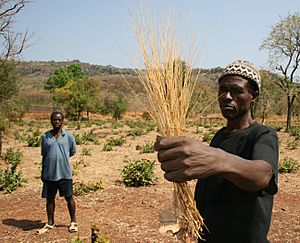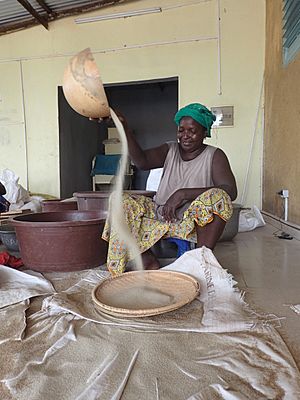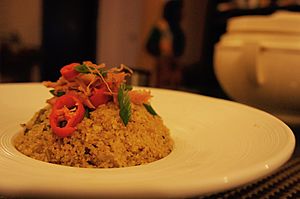Fonio facts for kids
Fonio is the name for two types of special grasses grown in West Africa. These grasses are a kind of millet and have very tiny grains.
Fonio is a healthy food that tastes good. People mostly eat it in West African countries, where it is also grown. In 2019, Guinea grew most of the world's fonio, making over 75% of it! The word fonio comes from the Wolof language.
In 2018, the European Union said it was okay to sell fonio as a new food there. This happened after an Italian company asked to make and sell new food products with fonio.

What are the Types of Fonio?
There are two main types of fonio. They are both important crops in West Africa.
White Fonio
White fonio, also known as Digitaria exilis, is the most common type. Europeans sometimes called it "hungry rice." It grows in the savannas of West Africa. Fonio has the smallest seeds of all the millets.
This grain is very good for you. It is gluten-free and has lots of dietary fiber. Fonio grows very quickly, sometimes ready to harvest in just six to eight weeks! People use the grains to make foods like porridge, couscous, bread, and even beer.
Black Fonio
Black fonio, or Digitaria iburua, is another similar crop. It is grown in several West African countries. These include Nigeria, Togo, and Benin.
How is Fonio Grown and Prepared?
Fonio grows well in dry places without needing extra water. It likes light soils, like sandy or stony ground, and can even grow in poor soil. It takes about 70 to 130 days for fonio to grow, depending on the type.
Growing and preparing fonio takes a lot of hard work. Men and boys use special curved knives called sickles to cut the fonio plants. Then, women gather the plants into bundles and let them dry.
Next, the grains need to be separated from the plants. This is called threshing. Women usually spread the fonio on mats and use their feet to separate the grains. After that, the grains are washed by hand.
It can be tricky to remove the outer shell, or husk, from the tiny fonio grains. Traditionally, people would pound the grains in a bowl with sand. Then, they would separate the grains from the sand. Another way is to quickly heat the grains over a flame before pounding them. This gives the grains a toasted color. Luckily, a special fonio husking machine was invented to make this job much easier!



